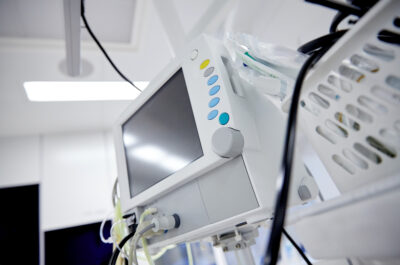ECMO, which stands for Extra Corporeal Membrane Oxygenation is a life-giving, last-resort machine. It is not as well-known as a ventilator, and it is different and vastly more complex than a ventilator. We have blogged about it previously, and now it’s time to renew some information on it.
You see, ECMO is in the news again, as we continue our fight against COVID-19 variants. Previously the ECMO machine was reserved for last resort patients. Now, it is often used for lung transplant patients. However, in some hospitals, it is saving the lives of patients stricken with Covid-19 variants.
ECMO: Bringing Patients A Literally Out-of-the-Body experience

In the Sea of COVID-19 and Lung Disorders, ECMO Machines Save Thousands of Lives.
As we have stated previously, “The ECMO literally provides an out of the body experience, not in a metaphysical sense, but in a very real way.”
- From outside your body, the ECMO breathes for you.
- Yes, it is similar to a respirator or a heart-lung machine, but it is so much more.
- The sophisticated ECMO machine is saving the lives of patients who are in acute respiratory distress.
- Likewise, it has saved the lives of patients on a short-term waiting list to receive a lung transplant.
- Now there is a portable version of ECMO that allows patients to eat, and even walk short distances in the hospital hallways.
ECMO Review: Steps in the Live-Saving Process
Of all life support systems, this is the machine that acts most like a pair of human lungs, even at the molecular level. Let’s look at the process:
ECMO is on the cutting edge of technology. Additionally, it directly oxygenates and removes carbon dioxide from the blood.
1. How the Blood Gets Into the Machine: The doctor installs a special catheter into a central vein. Normally, it’s one near the heart.
2. Then, the ECMO system pump draws blood from the vein into the circuit. Yes, amazing as it seems, the patient’s blood is “removed from the body.” Then, it is “directed through the ECMO machine, and routed back in, through a system of tubes.”
3. What Happens Next? Once the blood is in the machine, it passes along a membrane (referred to as an “oxygenator” or “gas exchanger.”)
This process provides an interface between the blood and freshly delivered oxygen. This action is exactly what your lungs do for you, every breath of every day.
A Final, But Important Step:

Medicine and Technology Meet in the ECMO. However, Even Sophisticated Machines Have Rescued Thousands of Lives.
The ECMO system warms or cools the blood needed. Then it is returned either to a central vein (“venovenous ECMO”) or to an artery (“venoarterial ECMO”).
Note for the Deep Readers: Venovenous ECMO provides respiratory support alone. However, the venoarterial ECMO provides both respiratory and hemodynamic (blood pressure) support.
The Amazing ECMO Portable Technology
New technology has created a portable version of this machine that has allowed patients to talk and even eat. Most astonishingly, patients are allowed to carefully walk the hospital hallway. Of course, they are under the supervision of their medical team. Likewise, experts have lauded the machine because it does not instigate the kind of damage or side effects of other types of ventilation machines.
To put it briefly, ECMO supports the failing respiratory system. Additionally, in some cases, it helps patients gain strength as they await lungs for a transplant. Patients helped by ECMO tolerate their surgery lung transplants better.
And now, in the time of the COVID-19 variants, it has proven itself to be a last resort machine. As such, It has rescued patients who are young and strong but need time for their lungs to heal to survive the Delta variant.
The Gift of the ECMO Machine: Time to Heal
Because of the way this technology works, ECMO allows the patient’s lungs to get some rest and heal, as they overcome the COVID variant (Delta, currently.)
We are sure you are thinking that this is a magnificent piece of equipment and everyone fighting critical COVID-19 Delta should have access to one.
However, there is one flaw. The ECMO is not only expensive. It is labor-intensive. It requires a monitoring team with an around-the-clock full-time nurse and specialists.
Specialized Teams in the Time of Covid: Hard to Find

COVID-19 Has Challenged Medical Manufactures to Produce Massive Numbers of Life Support Machines.
Medical personnel is in short supply everywhere. This alone makes it hard to find hospitals that can spare the staff to work with them.
Additionally, ECMO machines are “in limited supply. The “shortage is sending desperate patients thousands of miles across the country and forcing loved ones to make hundreds of calls to nearby hospitals in the hopes of getting their hands on one.”
In spite of the shortage, the Miami Herald recently reported this news. “Since the establishment of the Medical ECMO Program, many patients have recovered using this therapy who likely would not have survived otherwise.”
Who Needs the ECMO Machine?
ECMO may benefit patients in cases such as the following:
- If a patient has a life-threatening acute respiratory failure with profound gas exchange abnormalities, doctors might recommend ECMO to rescue the patient.
- Patients with ARDS who would benefit from lung-protective ventilation strategies but who are unable to tolerate the ventilator, often benefit from this machine.
Special Note about ARDS
ARDS stands for acute respiratory distress syndrome. You should know that it is a serious complication. And it is due to widespread inflammation of the lungs. (Needless to say, COVID 19 could certainly cause this inflammation).
- The inflammation process causes fluid to leak into the tiny air sacs (alveoli) where oxygen exchange occurs. Then, the patient is in trouble.
- Subsequently, the fluid decreases the capacity for oxygen and carbon dioxide to exchange across the alveolar capillaries.
- Finally, this leads to low oxygen and high carbon dioxide levels in the blood. If left unchecked, this condition starves the body of oxygen and raises carbon dioxide levels.
With all these points in mind, it is easy to see why patients with chronic lung disease (already listed for lung transplantation) call the ECMO machine the “bridge-to-transplantation.”
Shortages: Final Take

FLASS Technology Brings Compassion to Patients and Family. Critical Care Involves More Than Machines.
The shortages of both ECMO machines and medical personnel have limited the availability of this specialized treatment. At FLASS, we find this very sad, because experts claim the specialized machine can save the lives of many who are afflicted with Covid-19.
Just in case you’re curious, according to data from the ELSO registry, 7,581 COVID-19 patients initiated ECMO at least 90 days ago as of Sept. 16. That is quite a large number of suffering patients in critical condition. But they are the lucky ones. You see, this wonderful machine almost doubles their survivability.
If afflicted with a COVID-19 variant you might need this intense and sophisticated machine. However, we hope you never need one. And so, we leave you with this final thought.
The first step to avoiding this specialized technology is to get fully vaccinated for COVID-19. As always, we thank you for reading the FLASS blog.

